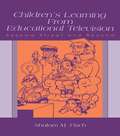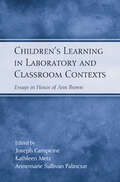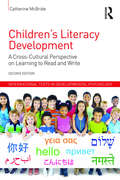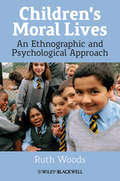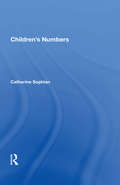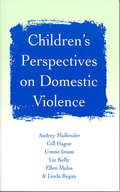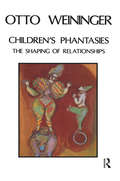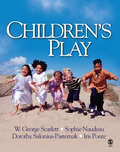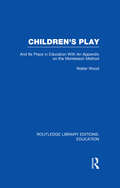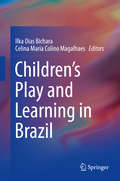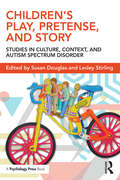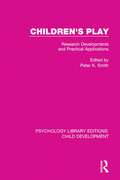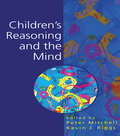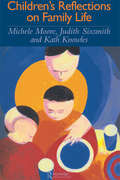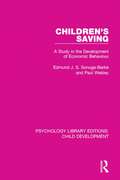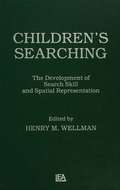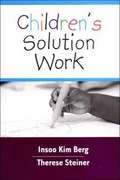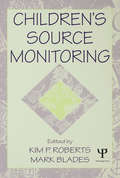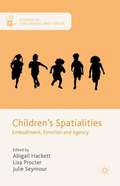- Table View
- List View
Children's Learning From Educational Television: Sesame Street and Beyond
by Shalom M. FischAt its best, educational television can provide children with enormous opportunities and can serve as a window to new experiences, enrich academic knowledge, enhance attitudes and motivation, and nurture social skills. This volume documents the impact of educational television in a variety of subject areas and proposes mechanisms to explain its effects. Drawing from a wide variety of research spanning several disciplines, author Shalom M. Fisch analyzes the literature on the impact of educational resources. He focuses on television programs designed for children rather than for adults, although adult literature is included when it is particularly relevant. In addition, much of the discussion concerns the effects of unaided viewing by children, rather than viewing in the context of adult-led follow-up activities. The role of parent-child co-viewing and issues relevant to the use of television in school or child care also receives consideration. This volume is intended to make the disparate literature on educational television's impact more accessible, by bringing it together into a centralized resource. To that end, the volume draws together empirical data on the impact of educational television programs--both academic and prosocial--on children's knowledge, skills, attitudes, and behavior. In addition to its emphasis on positive effects, this volume addresses a gap in the existing research literature regarding children's learning from exposure to educational television. Acknowledging that little theoretical work has been done to explain why or how these effects occur, Fisch takes a step toward correcting this situation by proposing theoretical models to explore aspects of the mental processing that underlies children's learning from educational television. With its unique perspective on children's educational television and comprehensive approach to studying the topic, this volume is required reading for scholars, researchers, and students working in the area of children and television. It offers crucial insights to scholars in developmental psychology, family studies, educational psychology, and related areas.
Children's Learning in Laboratory and Classroom Contexts: Essays in Honor of Ann Brown
by Joseph Campione Kathleen MetzDuring the second half of the twentieth century, Ann Brown was one of the worlds premier researchers into the cognitive development of young children. Sponsored by the Spencer Foundation, this edited festschrift honors her work and memory by bringing together a collection of original studies that extend many of the theories and themes of
Children's Life-Histories in Primary Schools: Imagining Schooling as a Positive Experience (Palgrave Critical Perspectives on Schooling, Teachers and Teaching)
by Eleanore Hargreaves Laura Quick Denise BuchananThis open access book explores schooling from the perspective of children via data from a longitudinal life-history study. It questions whether schooling creates an environment where all children to flourish; or whether a policy focus on attainment in mathematics and English hinders some children’s wellbeing and learning. By drawing on the children’s life-history narratives and their ideas, the chapters also portray children’s realistic suggestions for practices that meet the needs of diverse children and strengthen their comprehensive wellbeing and learning within schooling.
Children's Literacy Development: A Cross-Cultural Perspective on Learning to Read and Write (International Texts in Developmental Psychology)
by Catherine McBrideIn the thoroughly updated second edition of this unique book, Catherine McBride examines how the languages we know help structure the process of becoming literate. Taking an ecological and distinctively cross-cultural perspective, the book looks at reading and writing development and impairment across a range of languages, scripts, and contexts. The book covers issues including: The importance of phonological sensitivity for learning to read and to write The first units, or building blocks, of literacy learning in different scripts such as Chinese, English, Korean Hangul, Hebrew, Hindi and Arabic The role of visual processing in reading and writing skills How the latest research can inform the teaching of reading An overview of our understanding of dyslexia, including recent neuroscientific research The developmental challenges in becoming biliterate What is special about writing for beginners and later for comprehensive writing Basics of reading comprehension Children’s Literacy Development, Second Edition is a timely and important contribution to our understanding of literacy around the world. Written by an eminent scholar in the field, it is the only book available that provides an overview of how children learn to read and write in different languages, and will be essential reading for all students of Developmental Psychology, Educational Psychology, Psycholinguistics and Speech Therapy.
Children's Literacy Development: A Cross-Cultural Perspective on Learning to Read and Write (International Texts in Developmental Psychology)
by Catherine McBrideIn the updated third edition of this unique book, Catherine McBride looks at reading and writing development and impairment across a range of languages, scripts, and contexts. This new edition highlights multiliteracy and multilingualism and broadly explores the science of reading.A timely and important contribution to our understanding of literacy around the world, the book includes a new chapter covering the impact of digital technology on children’s literacy development, and covers other issues including: The importance of phonological sensitivity for learning to read and to write The first units, or building blocks, of literacy learning in different scripts such as Chinese, English, Korean Hangul, Hindi and Arabic The role of visual processing in reading and writing skills How the latest research can inform the teaching of reading and writing An overview of of dyslexia and dysgraphia, including recent neuroscientific research The developmental process of becoming biliterate What is special about writing for beginners and later for comprehensive writing Basics of reading comprehension Written by an eminent scholar in the field, it provides an overview of how children learn to read and write and is essential reading for students and scholars of Developmental Psychology, Educational Psychology, Psycholinguistics and Speech Therapy.
Children's Moral Lives
by Ruth WoodsChildren's Moral Lives makes use of case studies, observation, interviews and questionnaires to offer a fascinating, behind-the-scenes view of children's school lives and the complex moral issues and disputes they routinely negotiateThe first ethnography of childhood to focus on children's morality in the peer groupCase studies shed light on the psychological, social and cultural processes by which children and adults reach starkly different moral judgments of the same situationsCombines qualitative insights and quantitative data into recommendations for practice
Children's Numbers
by Catherine SophianSynthesizing research on numerical development, the book explores the implications for instruction, drawing upon the ideas of Piaget, Vygotsky, and several contemporary cognitive-developmental theorists. The text is intended for use in undergraduate and graduate-level courses in developmental psychology and education. Children’s developing underst
Children's Peer Talk
by Asta Cekaite Shoshana Blum-Kulka Vibeke Grøver Eva Teubal Asta Cekaite Shoshana Blum-Kulka Vibeke GrøverInside and outside the classroom, children of all ages spend time interacting with their peers. Through these early interactions, children make sense of the world and co-construct their childhood culture, while simultaneously engaging in interactional activities which provide the stepping stones for discursive, social and cognitive development. This collection brings together an international team of researchers to document how children's peer talk can contribute to their socialization and demonstrates that if we are to understand how children learn in everyday interactions we must take into account peer group cultures, talk, and activities. This book will be of interest to students and researchers in the fields of language acquisition, sociolinguistics, pragmatics and discourse analysis, and related disciplines. It examines naturally occurring talk of children aged from three to twelve years from a range of language communities, and includes ten studies documenting children's interactions and a comprehensive overview of relevant research.
Children's Perspectives on Domestic Violence
by Liz Kelly Linda Regan Gill Hague Audrey Mullender Umme F. Imam Ellen Malos`The research methodology and the problems encountered when studying a subject such as domestic violence, coupled with the ethical problems of researching with children, are discussed at length in the book. This gives a good insight into the intricacies of conducting such a research study. The research looked not only at children who were known to have direct contact with domestic violence, but also what children in general thought and felt about domestic violence. The presentation of the findings, both in tabular and narrative form, was well presented' - Accident and Emergency Nursing Journal `This book offers accessible and interesting reading. It is well written as one would expect from these authors.... There are a lot of pointers for the way forward in terms of both policy and practice. This is likely to become a seminal text' - Research Policy and Planning 'This is a useful and challenging read for all of us who seek to work effectively and ethically in this complex area of practice' - Professional Social Work `Just looking at the authors of this book tells the reader that they are about to embark on a pioneering piece of academic research... a comprehensive and authoritative piece of work' - Domestic Abuse Quarterly `A vital tool for all those working with children' - ChildRight 'Written in a lucid style and is easy to read... it is essential reading for all students in social work undergraduate courses and also in post-qualifying courses on child welfare and protection. In addition professionals who are directly working in the area of child protection, schools and criminal justice settings would find this book informative and useful in understanding what children and young people want, and need, in relation to living in domestic violence situations' - Child and Family Social Work 'This book is powerfully written and is essential reading for professional working with and supporting abused women and their children. Its groundbreaking focus on children's experiences adds much to our understanding of the complexities of domestic violence' - Journal of Family Studies 'A treasure-chest of rich, diverse and powerful extracts from children and young people... in particular the material presented on different coping strategies used by children who have experienced domestic violence is an important contribution to an area about which very little is known' - Adoption and Fostering Journal How do children who live with domestic violence cope? How do they make sense of their experiences? Do they receive the right sort of help from formal and informal sources? Drawing on the newest research designed to hear the voices of children and young people, this important book examines children's experiences and perspectives on living with domestic violence. The authors explore: - the effect of domestic violence on children - what children say would help them most in coping with domestic violence - the advice children would offer other children who find themselves in similar circumstances, their mothers and the helping professions. This accessible book written for students, their teachers, researchers and all those working with children - across social work, health, child psychology and psychiatry, the law and education - will provide a vital insight into children's own perspectives on domestic violence.
Children's Phantasies: The Shaping of Relationships
by Otto WeiningerOtto Weininger illustrates the manifestations of unconscious phantasy in children - normal, neurotic or psychotic - in various settings such as playgroups, ordinary schools or special schools for disturbed children, the family milieu or play therapy. He uses Melanie Klein's developmental theory and shows the evolutions of phantasies in their content, in the way they are symbolizes, and their functioning in terms of the child's evolution from the paranoid-schizoid position to the depressive position and Oedipus complex.
Children's Play
by Dr W. George Scarlett Iris Chin Ponte Professor Sophie C. Naudeau Dorothy Salonius-PasternakChildren's Play looks at the many facets of play and how it develops from infancy through late childhood. Authors W. George Scarlett, Sophie Naudeau, Dorothy Salonius-Pasternak, and Iris Ponte take a broad approach to examining how children play by including a wide variety of types of play, play settings, and play media. The book also discusses major revolutions in the way today's children play, including changes in organized youth sports, children's humor, and electronic play. Children's Play addresses diversity throughout the text and explores play on the topics of gender, disabilities, socioeconomic class, and culture.
Children's Play and Development: Cultural-Historical Perspectives (International Perspectives on Early Childhood Education and Development #8)
by Ditte Winther-Lindqvist Ivy SchousboeThis book provides new theoretical insights to our understanding of play as a cultural activity. All chapters address play and playful activities from a cultural-historical theoretical approach by re-addressing central claims and concepts in the theory and providing new models and understandings of the phenomenon of play within the framework of cultural historical theory. Empirical studies cover a wide range of institutional settings: preschool, school, home, leisure time, and in various social relations (with peers, professionals and parents) in different parts of the world (Europe, Australia, South America and North America). Common to all chapters is a goal of throwing new light on the phenomenon of playing within a theoretical framework of cultural-historical theory. Play as a cultural, collective, social, personal, pedagogical and contextual activity is addressed with reference to central concepts in relation to development and learning. Concepts and phenomena related to ZPD, the imaginary situation, rules, language play, collective imagining, spheres of realities of play, virtual realities, social identity and pedagogical environments are presented and discussed in order to bring the cultural-historical theoretical approach into play with contemporary historical issues. Essential as a must read to any scholar and student engaged with understanding play in relation to human development, cultural historical theory and early childhood education.
Children's Play and Its Place in Education: With an Appendix on the Montessori Method (Routledge Library Editions: Education)
by Walter De Burley WoodPublished long before the importance of early childhood education was formally recognised in the educational landscape this book explores the significance of play for young children. The volume includes an appendix on Montessori education.
Children's Play and Learning in Brazil
by Ilka Dias Bichara Celina Maria MagalhaesThis book presents for the first time in English language an overview of the research done in Brazil in the field of studies of children’s play. The volume brings together contributions from researchers of the Working Group Toy, Education and Health, of the Brazilian National Association of Research and Graduate Studies in Psychology (ANPEPP), including empirical studies and literature reviews about indigenous children, riverside communities, urban children in situation of social vulnerability, projects of early childhood education and the ludic possibilities of digital technologies. It aims to show the cultural diversity of Brazil expressed in its children’s play, providing valuable resources for international researchers of play interested in intercultural studies.
Children's Play, Pretense, and Story: Studies in Culture, Context, and Autism Spectrum Disorder
by Susan Douglas Lesley StirlingAt the heart of this volume is the recognition that children’s engagement with play and story are intrinsically and intricately linked. The contributing authors share a passionate interest in the development and well-being of children, in particular through their use of imagination and adaptation of the everyday into play and stories. Following these principles, the volume explores the connections between play, story, and pretense with regard to many cultural and contextual factors that influence the way these elements vary in children’s lives. In a departure from earlier collections on play and story, the authors take a particular focus on normative as compared with atypical development. This collection begins with an approach to understanding the developmental relationship between play and story, which recognizes their similarities while acknowledging their differences. Much of the collection addresses pretend play and story in children with autism spectrum disorder, an understudied but important group for consideration, as these dimensions of their lives and development have often been considered problematic. The volume also includes sections on play and story in classroom settings and play and story across cultures, including non-English-speaking environments such as Israel, Romania, China, and Mexico. It concludes with a discussion of how play differs across sociocultural and economic contexts, making a unifying claim for the importance of play in children’s lives but also calling for an understanding of what play means to very different groups of children.
Children's Play: Research Developments and Practical Applications (Psychology Library Editions: Child Development #14)
by Peter K. SmithOriginally published in 1986, in this compendium of recent research on children’s play, acknowledged experts review the latest methodologies and ideas, examine salient problems, and reveal the application of current knowledge in several areas of professional practice at the time. Exciting new results embracing a wide area of investigation – the development and measurement of play in young children, the training of symbolic play, play and learning with computers, language play, play and handicapped children, play therapy, and outdoor play – will still be of considerable interest to teachers, nursery and day care personnel, social workers and students of psychology and education.
Children's Reasoning and the Mind
by Peter Mitchell Kevin John RiggsThis fresh and dynamic book offers a thorough investigation into the development of the cognitive processes that underpin judgements about mental states (often termed 'theory of mind') and addresses specific issues that have not been adequately dealt with in the past, and which are now being raised by some of the most prominent researchers in the field.
Children's Reflections On Family Life
by Suzan Lewis Michele Moore Carolyn Kagan Sarah Beazley Judith Sixsmith Kathleen Knowles Usha RoutHow important is the family for children? How do children cope when parents have to juggle child care, employment and other responsibilities? In this volume these questions, and others, are raised and reflected upon, by children themselves, providing insights for parents and professionals.
Children's Responses to the Screen: A Media Psychological Approach (Routledge Communication Series)
by Patti M. ValkenburgThe past several decades have witnessed thousands of studies into children and the media. Yet, much academic research is still in its infancy when it comes to our knowledge about the uses, preferences, and effects of different media. This distinctive volume moves the field forward in this regard, with its insights into the latest theories and research on children and the media. Author Patti M. Valkenburg explores "screen" media (i.e., television, films, video and computer games, and the Internet), and focuses her study on the most fundamental topics in the study of children and the media. In each chapter, Valkenburg examines an essential topic on children and the media: the effect of media violence, children's emotional reactions to news and entertainment, the intended and unintended effects of advertising, and the uses and effects of computer games and the Internet. She has structured the chapters to provide an overview of existing theories and research on a particular topic, and supplements the work of others with her own ground-breaking research findings. She provides a careful and even-handed treatment of research in children's media, and includes current and noteworthy studies. As a resource for study in children and media and media psychology, this volume provides a timely and thorough examination of the state of theory and research. It will serve as a valuable reference for scholars and as an engaging text for advanced students.
Children's Saving: A Study in the Development of Economic Behaviour (Psychology Library Editions: Child Development #15)
by Paul Webley Edmund J.S. Sonuga-BarkeOriginally published in 1993, this book presents an alternative approach to the study of the emergence of economic awareness during childhood: a new developmental economic psychology! In the past, attempts to study the emergence of children’s economic consciousness have failed to take account of the practical nature of the "economic" in the history of western cultures. Economic socialisation has been seen as the acquisition of abstract knowledge about the institutions of adult economic culture. The child has been seen as a spectator, acquiring knowledge of that culture, but never really a part of it. However, economic actions, in essence, are directed not towards the attainment of knowledge, but rather towards the practical solution of problems of resource allocation imposed by constraint. Children, just like adults, are faced with practical problems of resource allocation. Their response to these problems may be different from those of adults but no less "economic" for that. This realisation forms the heart of this book. In it children are seen as both inhabitants of their own "playground" economic subculture and actors in the wider economic world of adults, solving, or attempting to solve, practical economic problems. In order to highlight this "child-centred" approach, the authors studied the way children tackle the particular problems posed by limitations of income. How do children learn (a) the relationship between choices available in the present and the future, (b) to spread their limited financial resources over time into the future and (c) about the strategies, such as banking, that allow them to protect those resources from threats and temptations? In short, how do children learn to save? This volume goes some way to answering these and related questions and in so doing sets up an alternative framework for the study of the emergence of economic awareness.
Children's Searching: The Development of Search Skill and Spatial Representation
by Henry M. WellmanPublished in 1985, Childrens Searching is a valubale contribution to the field of Developmental Psychology.
Children's Sibling Relationships: Developmental and Clinical Issues
by Judy Dunn Frits BoerIn the last decade, the significance of siblings in children's development and adjustment has been widely recognized, and research on brothers and sisters has increased dramatically. Bringing together exciting research on siblings by leading developmental psychologists and clinicians, this volume's contributions were originally presented at the First International Symposium on Siblings held in Leiden. This book focuses on both the significance of siblings as influences on individual development, and on the importance of the relationship in families with sick, disabled or troubled children. It covers the recent developmental research with chapters on the development of sibling relationships in early and middle childhood, the links between sibling relationships and those with parents, peers and friends, and the influence of siblings on children's adjustment. It then focuses on clinical issues such as siblings as sources of support for unhappy or sick children, or for children in disharmonious homes, and the vulnerability of siblings of disabled children. These clinical issues are discussed in practical terms by leading practitioners. Clear in presentation, comprehensive in its coverage of the exciting recent research, and full of practical insights, this volume brings to light important developmental principles, and raises questions regarding the assumptions about family processes and how different relationships within the family affect one another. For family researchers, those interested in the individual development of children, and for clinicians concerned about the impact of troubled or disabled children on their siblings or the potential of siblings as therapists, this book will be the key. No other book covers the recent research in this important topic and discusses the clinical issues in depth and in practical terms.
Children's Solution Work
by Insoo Kim BergFocusing on solutions and not problems, thinking about the future and not the past, and understanding the effects of miracles―children do these things naturally. Here, leaders in the solution-focused approach to therapy provide clinicians with a guide to a kind of therapy that fits with children's natural way of being.
Children's Source Monitoring
by Mark Blades Kim P. RobertsThere are many aspects of life which require us to distinguish between memories of different events, such as deciding whether you locked the door or only intended to lock the door. Source monitoring, or identifying the source of a particular memory (was the event experienced? related by someone else? or simply imagined?) is a cognitive skill that develops across the life span. In this book, the first to integrate research on children's source monitoring, readers will find an accessible overview of source-monitoring theory and findings from the research programs of leading investigators in this area. The programs of research cut across different methodologies (e.g., nomothetic, individual differences, clinical) and are applied to a wide range of issues in children's lives. Particular emphasis is placed on the effects of source monitoring on eyewitness memory and identification, learning and knowledge, and the development of a theory of mind.
Children's Spatialities: Embodiment, Emotion and Agency (Studies in Childhood and Youth)
by Julie Seymour Abigail Hackett Lisa ProcterDrawing from a wide range of disciplines, including anthropology, sociology, architecture and geography, and international contributors, this volume offers both students and scholars with an interest in the interdisciplinary study of childhood a range of ways of thinking spatially about children's lives.
